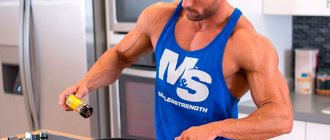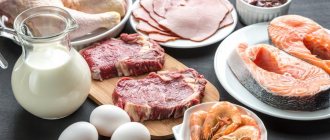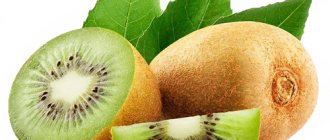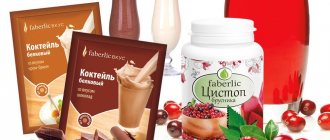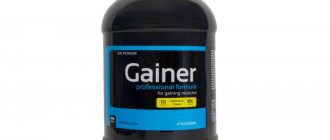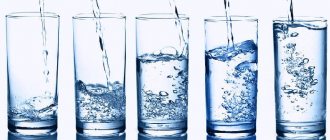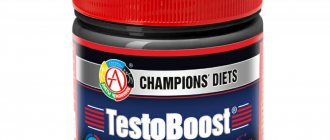It is difficult to create a beautiful and sculpted body with strength training alone. Proper nutrition also plays an important role in the process of gaining muscle mass. Consuming the right nutrients helps in building muscle as their nutritional value significantly speeds up the growth process.
We have prepared a list of 10 products that an athlete primarily needs. We chose only the main products, in fact there are many more.
Basic nutrition rules for those who want to pump up
Whole egg
* 100 g of eggs contains about 12 g of protein, 10 g of fat and less than 1 g of carbohydrates. Calorie content – 157 kcal.
Why are whole eggs so valuable? This product is called the “gold standard”, because they contain beneficial substances in ideal proportions. Relatively cheap food is effectively used by the body for all kinds of growth. They are also ideal for restoring muscles after a workout. Many people separate the yolk from the white, but it has long been known that the biological value of an egg is more effective if it is eaten all together.
Cottage cheese
* 100 g of cottage cheese contains 16-18 g of protein, about 9 g of fat and about 2 g of carbohydrates. Calorie content - 159 kcal.
Cottage cheese is a real treasure for athletes. The dairy product contains animal protein and has the necessary amino acids for gaining muscle mass. Casein contained in cottage cheese can saturate your body with energy for a long time. The composition of the product is also famous for calcium, phosphorus and iron.
Photo: istockphoto.com
Chicken breast
* From 100 g of chicken breast you can get from 23 to 29 g of protein, about 1.8 g of fat and 0.5 g of carbohydrates. Calorie content - 137 kcal.
Chicken breast is prized among athletes for its impressive amount of protein and low fat content. It contains B vitamins that help the body function fully during training. It has been proven that chicken protein hydrolyzate has no worse effect on muscle building than beef protein. Many athletes consider breast meat the best product for pumping.
How to create your own menu for the diet period
Nutrition for intensive weight gain is simple and affordable. A special menu does not require exotic fruits or expensive goods. The main point is to follow the basic rules of eating at home to increase muscle:
- In the morning, the body needs more slow carbohydrates. They provide physical and mental performance throughout the day. An example of a carbohydrate breakfast would be oatmeal with some fruit. You can also use healthy options for breakfast cereals - whole grain muesli, granola with nuts, etc.
- Lunch is the main meal. The body should receive the maximum amount of carbohydrates, proteins and fats at lunch. This meal minimizes the intake of extra calories in the evening and the increase in fat reserves. The best option for lunch would be vegetable soup, a portion of lean meat or fish with a side dish.
- Dinner involves light protein dishes. The basis for any dinner is lean meat/poultry/fish with a light salad of seasonal vegetables. It is also useful to eat porridge - buckwheat, pearl barley, etc.
You should add healthy snacks between main meals. Omelettes, small portions of nuts and dried fruits are perfect for this purpose.
Fish
* 100 g of trout contains 18.5 g of protein, 4.5 g of fat and 0.38 g of carbohydrates. Calorie content - 121 kcal.
This product helps increase protein intake and reduce calorie intake. If you want to create a diet that is low in calories and high in nutrients, fish is an ideal choice. In addition, it contains healthy fatty acids. For example, omega-3 is famous for accelerating muscle growth. Also, many types of fish contain selenium and iodine, which protect cells from damage.
Photo: istockphoto.com
Beef
* 100 g of lean beef contains 22 g of protein, 7 g of fat and 0 g of carbohydrates. Calorie content - 158 kcal.
Beef contains large amounts of protein, iron and creatine. We've heard a lot about the properties of protein and iron, now let's talk about creatine. Creatine helps normalize metabolism and restore acidity in the body. This component helps to effectively build muscle mass, while increasing muscle strength in general. Creatine is rightly called one of the main sources of muscle energy.
Training without results. What to eat to make muscles grow
What to eat to gain muscle and weight: list of the best foods
An athlete's diet should include foods that are well digestible and beneficial to the body. What is better to eat: complex carbohydrates, proteins and fats (mostly vegetable). The table shows the TOP products on the basis of which you can create a menu.
| Squirrels | Fats | Carbohydrates |
| Egg white | Vegetable oils | Bread |
| Beans | Nuts | Porridge |
| Fish | red fish | Pasta |
| Bird | Dairy | Potato |
| Meat | Egg yolk | Fruits |
| Dairy | Peanut paste |
Important! The listed products are useful sources of nutrients, and it is on their basis that you should draw up a nutrition plan for mass gain.
Milk
* 100 g of milk contains 3.2 g of protein, 4.8 g of carbohydrates and 3.6 g of fat. Calorie content - 64 kcal.
Casein is one of the main components of milk. Due to its slow absorption properties, casein ensures the transfer of amino acids to muscle tissue. Milk contains calcium, which is beneficial not only for bones, but also for muscles. This product is also rich in B vitamins. For example, riboflavin ensures energy metabolism in the body, and carbohydrates and fats obtained from food provide energy.
Photo: istockphoto.com
Proper water consumption while building muscles
Gaining weight through muscle mass is simply impossible without maintaining a healthy balance of water in the body. Lack of moisture can be one of the main reasons for training stagnation and lack of athletic progress. The optimal amount of clean water for increasing lean muscle mass is 1.5-3 liters, depending on your current weight.
However, you should absolutely not drink water while eating. It will create a barrier to the natural process of digesting food and absorbing useful components. The best option is to drink water between main meals.
It is also important for athletes’ diets what to drink during the day. To replenish moisture reserves, plain water, weak green tea, or a special electrolyte solution are best.
Nuts
* We take almonds as a base. 100 g of almonds contain more than 18 g of protein, 53 g of fat and about 13 g of carbohydrates. Calorie content - 597 kcal.
We have been told about the benefits of nuts since childhood, but few know what exactly this product is good for. Many types of nuts contain significant amounts of protein. Nuts are one of the best plant sources of omega-3 fatty acids. The product's properties also contain fiber and vitamin E, which expand the channels for delivering blood and nutrients to cells. Eating nuts makes the walls of blood vessels in our body more flexible.
Oatmeal
* 100 g of boiled oatmeal contains about 12 g of protein, 65 g of carbohydrates and 5-6 g of fat. Calorie content - 350 kcal.
Oatmeal is the most popular porridge among athletes. Oatmeal not only helps you gain muscle mass, but also promotes weight gain and loss. Oatmeal stabilizes blood sugar and lowers cholesterol. In addition to fiber, this product contains protein compounds necessary for building muscle fibers, as well as healthy fats. Oatmeal contains almost all the beneficial properties - it contains magnesium, iron, phosphorus, iodine, calcium, potassium and other necessary components. The porridge is rich in antioxidants, omega-3 fatty acids and folic acid.
Photo: istockphoto.com
An example of a ready-made menu for each day of the week
An approximate menu option allows you to get used to the new diet and learn how to properly distribute calories throughout the day. As you get used to it, you will be able to vary different dishes based on this pattern.
For teenagers 15-18 years old
| Breakfast | Dinner | Dinner | |
| 1 | Oatmeal with milk | Boiled chicken fillet + rice | Cottage cheese + fruit |
| 2 | Whole grain muesli with yogurt | Bean soup | Chicken cutlets with buckwheat |
| 3 | Oatmeal + fruit | Steamed meatballs + potatoes | Vegetable stew and omelet |
| 4 | Rice porridge with dried fruits | Baked chicken breast + vegetable salad | Beans in tomato + fish fillet |
| 5 | Oatmeal with nuts | Stew with lean beef | Cottage cheese + dried fruits |
| 6 | Muesli with milk | Creamy chicken soup | Baked fish with vegetables |
| 7 | Rice porridge + fruit | Boiled chicken + puree | Buckwheat with lean beef (stewed version). |
For men
| Breakfast | Dinner | Dinner | |
| 1 | Oatmeal + omelet with milk | Baked chicken breast + buckwheat | Low-fat cottage cheese + dried fruits |
| 2 | 2 eggs + corn flakes | Pea and Lentil Soup | Chicken chop with buckwheat + light salad |
| 3 | Oatmeal with milk + boiled egg | Meatballs + vegetable side dish | Baked vegetables + cheese omelette |
| 4 | Rice with dried fruits and nuts | Baked fish + salad | Beans + chicken fillet |
| 5 | Oatmeal with omelet | Buckwheat soup + boiled egg | Cottage cheese + fruit |
| 6 | Rice with milk + fruit | Vegetable stew with chicken | Baked fish + potatoes |
| 7 | Oatmeal + banana | Grilled fish + mashed potatoes | Buckwheat with chicken/veal chop |
For women
| Breakfast | Dinner | Dinner | |
| 1 | Muesli with yogurt | Boiled chicken breast + buckwheat | Cottage cheese + fruit |
| 2 | Omelet with cheese | Vegetable soup + egg | Chicken cutlets + pasta (made from durum wheat) |
| 3 | Oatmeal + any fruit | Fish cutlets + vegetables | Fresh vegetables + omelette |
| 4 | Rice with nuts (peanuts, walnuts) | Baked veal + cabbage salad | Bean puree + chicken cutlet |
| 5 | Oatmeal with milk and honey | Chicken soup + boiled egg | Cottage cheese + fruit |
| 6 | Rice + fruit | Baked vegetables with chicken | Boiled fish + vegetable salad |
| 7 | Muesli + yogurt | Steamed fish + salad | Buckwheat with baked veal |
Buckwheat
* 100 g of buckwheat contains 4 g of protein, about 20 g of carbohydrates and 2 g of fat. Calorie content - 110 kcal.
Buckwheat is a complex carbohydrate. The body absorbs this product longer, prolonging the feeling of fullness. Buckwheat does not contain fats or simple carbohydrates, but it contains fiber, which is beneficial for the gastrointestinal tract. This cereal contains a lot of protein and amino acids - fundamental components for building muscle tissue.
Athletes advise
eat buckwheat porridge along with protein products of animal origin. If you combine cereals with eggs, fish and other dairy products, the protein from it will be absorbed much better.
Meal regimen: when and what to eat to build muscle
How to better distribute food and training
It is best to eat nutritious foods 2 hours before training. Give preference to dishes with a sufficient amount of complex carbohydrates. They give the body the necessary energy supply for an effective workout.
Important! The best option for eating before training is a portion of durum pasta, porridge or vegetables. A protein-carbohydrate mixture in the form of a cocktail will also be useful (you can drink it 30-60 minutes before the start of class).
Don't skip meals after finishing your workout. At this time, all substances important for muscle recovery are absorbed as actively as possible. Immediately after strength training, you should take a serving of Lily gainer or eat 2 bananas. A complex meal after 40-60 minutes should contain proteins and slow carbohydrates. This nutrition plan will speed up muscle recovery after active exercise.
What time to eat
In order for muscles to gradually increase in volume, athletes need to build a correct, balanced nutrition plan. Together with regular foods, the body receives the necessary energy and nutritional components that support important metabolic processes (including muscle tissue receiving “building” material for recovery and growth).
An increase in muscle mass occurs only when enough nutrients (protein, fat and carbohydrates) enter the body. For ordinary people, 3 meals daily is enough. For athletes who work for weight, long breaks between individual meals are not suitable. They create a certain nutrient and calorie deficiency. For this reason, for active weight gain, you should adhere to a schedule of 5-6 small portions of food every day (break - no more than 3 hours).
Such a meal schedule allows the body to digest incoming food much easier and faster, as well as promptly receive all the necessary substances to restore and increase muscle tissue.
Options for simple and tasty recipes for balanced dishes
Experimenting with familiar and healthy foods allows you to add special variety to your diet. By periodically changing your usual menu, you can easily stick to your chosen diet without resorting to unhealthy foods.
Buckwheat in a merchant's style. This dish combines the most useful products for the nutrition of an athlete “on the mass”. Required Products:
- buckwheat – 300 g;
- beef (it is better to choose a lean piece) – 200 g;
- onion – 1 pc.;
- carrot – 1 pc.;
- vegetable oil – 1 tbsp. l.;
- salt, pepper - add to taste.
First, chop the onion and grate the carrots. Cut the meat into small cubes. Take a deep frying pan, add vegetable oil and fry the onions, carrots and meat for 10 minutes. Then add a little water, spices and simmer over low heat with a lid. Boil the buckwheat and add to the pan after cooking the vegetables and meat. Mix all ingredients thoroughly and let sit for about 20 minutes before serving.
Lavash with tomatoes and cheese. This recipe is suitable as a breakfast dish, as a snack, or as an addition to a main course (for example, soup for lunch). If you don’t know how else you can eat cottage cheese, the option with lavash will greatly diversify your usual menu. For athletes, it is best to add cottage cheese that contains the least amount of fat to this dish. For preparation you need:
- lavash (Armenian, thin) – 1 pc.;
- cottage cheese – 200 g;
- grated cheese – 30 g;
- tomato – 1 pc.;
- bell pepper – 1 pc.;
- pickled cucumbers – 2-3 pcs.;
- salt, pepper, herbs - to taste.
First, salt the cottage cheese and spread it in a thin layer over the entire surface of the pita bread. Sprinkle the cottage cheese evenly with grated cheese on top and pepper. Then arrange the chopped vegetables and finely chopped herbs. Wrap a sheet of pita bread in a tube and cut with a sharp knife into equal portions of 3-4 cm.
Note! You can use your favorite vegetables and spices for the filling, and you can also change the types of cheese. This recipe is the basis for the most daring culinary experiments.
Beet
* 100 g of boiled beets contains 1.92 g of protein, 10 g of carbohydrates and 0.11 g of fat. Calorie content - 49 kcal.
The most unexpected product in our selection was beets. It has been proven that if you eat a couple of beet root vegetables an hour before training, you can feel an increase in energy. During your workout, your oxygen consumption will decrease, which will improve your performance for the next few hours. How does this happen? Mitochondria in muscle cells begin to work more intensely, thereby producing more energy.
Features of men's nutrition for weight gain
The diet for the stronger sex is different from that for women. It is high in calories (because men expend more energy), protein and carbohydrates. Typically, men work with significant weight and loads, and also need uniform training for the whole body.
Therefore, they do exercises for all muscle groups: back, chest, legs, arms, abs. Women usually do not pump up their arms or back, so their workouts are more gentle. All calculations are individual, based on the ratio of age, weight, height. In addition to proper nutrition, do not forget:
- drink at least 1.5 liters of water per day;
- exercise in the gym regularly - from 3 times a week;
- follow the advice of the trainer if he has drawn up an exercise program;
- stretch and alternate exercises for different muscle groups. Otherwise, you will get pumped up arms and weak legs.
- develop not only strength, but also endurance.
There is no point in artificially “inflating” without actual indicators. Such a mass disappears quickly. Useful for weight gain and sports nutrition.
